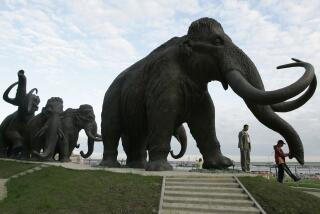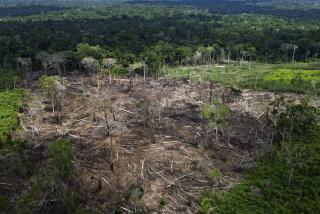Earth is on track for a mass extinction, and humans are to blame, study says
Today’s animal species are disappearing at a rate up to 100 times higher than they did in the past -- and humans are responsible, a new study warns.
Since the year 1500, at least 338 species of mammals, birds, reptiles, amphibians and fish have become extinct, researchers reported Friday in the journal Scientific Advances. Among the vanished are the Caribbean monk seal (Neomonachus tropicalis), the passenger pigeon (Ectopistes migratorius) and the dodo (Raphus cucullatus). Crucially, 198 of these species have been wiped out since 1900.
“We are on the trajectory of seeing a mass extinction in two human lifetimes if we just keep doing business as usual,” said Anthony Barnosky, a paleontologist in UC Berkeley’s integrative biology department and one of the authors of the study.
A mass extinction is indeed as dire as it sounds. To a paleontologist, it means that at least 3 out of every 4 species on Earth disappear in a relatively short period of geologic time (which could be as long as a couple of million years, Barnosky said).
Five mass extinctions have occurred so far in the history of life on Earth. The most recent of these events happened when a giant asteroid hit the planet about 65 million years ago, sealing the fate of the dinosaurs.
We’re now on the brink of a sixth mass extinction, the study authors said.
To figure out how animal species would have fared in the absence of humans, the researchers went to museums around the world and examined rocks containing fossils of 12,000 mammal species. By comparing fossils from different points in time, they determined that about 2 out of every 10,000 mammal species went extinct per century.
Then, to figure out just how quickly species are disappearing now, the scientists turned to the International Union for Conservation of Nature (IUCN) Red List, the most comprehensive inventory of global animal conservation status. The list told them that 35 of 5,513 known mammal species have gone extinct since 1900.
That means that since 1900, mammal species have been disappearing 28 times faster than would have been expected without the influence of humans, according to the study.
The researchers also ran the numbers with a more expansive group of extinct species. This time, they included mammals that were extinct in the wild but still alive in zoos and nature preserves, like the northern white rhino. They also included mammals that were believed to be extinct but whose status has not yet been definitively confirmed.
With these categories in the mix, the researchers counted 69 species that have become extinct since 1900. That is 55 times higher than the historical extinction rate, the study said.
Finally, the researchers turned their attention to other vertebrates – birds, reptiles, amphibians and fish. These counts weren’t as complete as the ones for mammals, but the researchers were able to estimate that 198 species had definitely become extinct since 1990 — a rate 22 times higher than in the time before humans had such influence on the planet.
Using the more liberal criteria, they tallied 477 vertebrate species that were either extinct, probably extinct or extinct in the wild. That worked out to a 20th century extinction rate 53 times higher than baseline levels. (Amphibians were the most vulnerable group in this analysis; their risk of extinction was elevated by a factor of 100, according to the study.)
These extinction rates are higher than at any time in the past that was not part of a mass extinction, the researchers said.
And humans are responsible, Barnosky said. People are putting other species in jeopardy by burning fossil fuels (thus changing the climate and acidifying the ocean) and by using 40% of the land to grow crops (and therefore depriving other animals of needed habitat).
Here’s another way to look at it: In the absence of human influence, “the number of species that have gone extinct in the last century would have taken, depending on the vertebrate taxon, between 800 and 10,000 years to disappear,” the study authors wrote.
Looking at each group of animals separately, they calculated that people were responsible for the premature extinction of 69 mammal species, 80 bird species, 24 reptile species, 146 amphibian species and 158 fish species.
The defunct species aren’t the only ones that suffer, Barnosky said. From a practical point of view, extinctions could devastate the world’s fisheries and destroy the ecosystems humans rely on to filter water, provide food, and get resources.
“There is so much at stake,” said Gerardo Ceballos, an ecologist at the National Autonomous University of Mexico and the lead author of the study. “Unless we do something radically different soon, we may end up having a big catastrophic collapse of humans, not only animals.”
About 1% of the world’s known 39,000 modern vertebrate species have been lost -- but 99% remain, Barnosky said.
“It’s not a done deal,” he said. “There’s still a lot we can do to reverse this. But if we do nothing, we’re screwed.”
For more science news, follow me on Twitter @sasha_hl and “like” Los Angeles Times Science & Health on Facebook.






